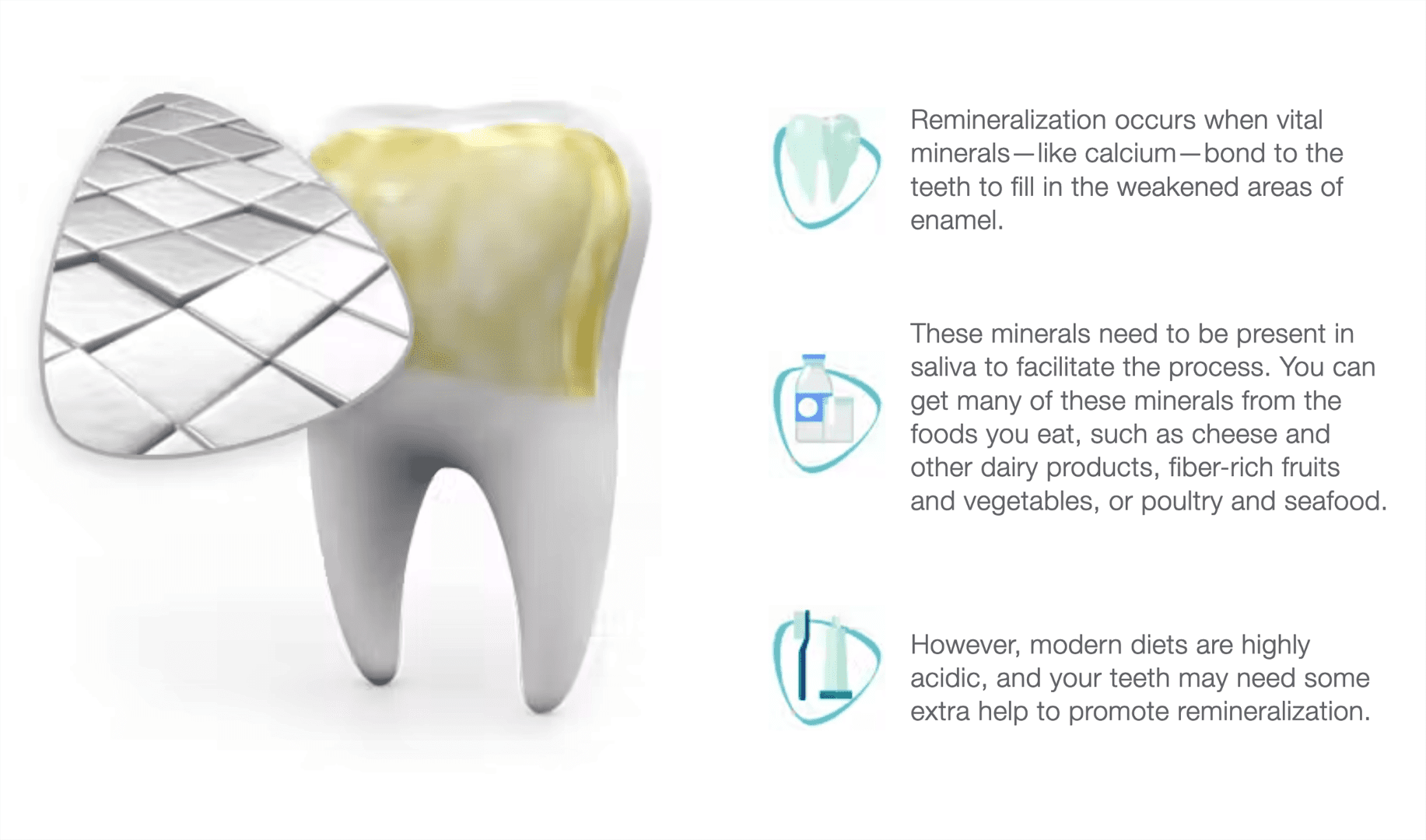
WHAT IS TOOTH REMINERALISATION?
FOR DR.ROZE BIOHEALTH CLINICS | 31.10.2022
Enamel protects the inner layers of your teeth from dietary acids, helping to keep them healthy and white. Once enamel wears away, it can’t repair itself. However, it is possible to repair and strengthen weakened enamel – a process known as ‘remineralisation’ – and protect your teeth from future erosion
1.What causes teeth to lose minerals?
Enamel can wear away for a variety of reasons, but one of the most common is erosion caused by acids in your diet. These acids attack your tooth enamel, wearing away the minerals that keep it strong – a process called ‘demineralization’. Over time, this weakens your enamel, and the loss of minerals can result in white spots on your teeth, as well as changes in their shape. Find out more about what causes tooth wear.
The good news is, before it’s worn away, acid-weakened enamel can be repaired and those important minerals can be restored. This is called ‘remineralisation’.

2. What causes tooth decay?
It is often forgotten that dental decay is actually an infection. It is a multifactorial disease involving the interaction of certain types of oral bacteria, diet, individual resistance (composition of your saliva, quality of your tooth structure), the tooth and time.
Weakening of tooth surfaces or demineralisation can occur underneath stagnant clumps of dental plaque containing acidogenic bacteria (Mutans Streptococci and Lactobacilli). These bacteria produce acid as a by-product of their functioning when they metabolise dietary sugars within the mouth.
For tooth demineralisation to occur, both acid producing bacteria and sugar must be present at the same time.
If these conditions exist frequently, over long periods of time, and are not adequately resisted with minerals in saliva (particularly in dry mouths), repeated sugar consumption and concomitant acid production by oral bacteria will keep the pH of saliva low (more acidic) and promote demineralisation – dissolving your tooth mineral to progressively deeper levels and lead to decay.
3. Demineralisation versus Remineralisation
There is this continuous dynamic, akin to a ‘tug of war’ which occurs between the impact of demineralisation (pathologic damage) and the effect of remineralisation (therapeutic repair) on teeth in the presence of saliva.
If the oral environment is acidic for hours at a time, demineralisation will promote dissolution or loss of tooth mineral. If conditions are neutral and less acidic for a greater length of time, remineralisation will attempt to repair or reverse the damage by incorporating the calcium, phosphate and hydroxyl minerals, found in saliva, back into teeth.
Over a period of time, there comes a point where the cumulative effect of more episodes of demineralisation outstrip the mouth’s capabilities for remineralisation and results in the formation of a cavity, which cannot be reversed, and needs to be treated with a dental filling. If the damage had not progressed beyond this point, the lost mineral may have been replaced over time, preventing the cavity.
By reducing the acidity of the oral environment, we can help promote conditions favouring more episodes of remineralisation over the longer term and protect teeth to avoid the need for fillings.
A tailored caries prevention program with remineralisation therapies
At Dr. Roze BioHealth Clinics, we can develop a caries prevention program specific to your needs. Following a thorough clinical and radiographic assessment for early diagnosis, appraisal of the quality of your tooth structure, your past caries history and current medical history, saliva testing and dietary evaluation, a comprehensive treatment plan can be recommended to manage any existing tooth decay and address your caries risk factors to prevent ongoing problems.
Our program aims to reduce the acidity of your saliva, and promote remineralisation. It includes restoring active decay (removing the acid producing bacteria from within decayed lesions and rebuilding the damaged tooth structure), teaching you efficient oral hygiene techniques and routines, along side appropriate dietary strategies and goals.
Advanced topical remineralising treatments may then be prescribed to help support a renewed oral environment that promotes healthy and strong teeth, for both well individuals and medically compromised patients with reduced saliva flow (such as those taking certain medications or undergoing treatments for cancer).
4. Tooth Remineralisation Treatments
Along with professional dental care, there are eight main ingredients/factors valued for promoting tooth remineralisation:
- Saliva : Both the quality and quantity of saliva is important (and may be supplemented with good hydration, activities which stimulate saliva flow or saliva substitutes in patients with dry mouth issues);
- Hydroxyapatite : Hydroxyapatite is one of the most studied biomaterials in the medical field for its proven biocompatibility and for being the main constituent of the mineral part of bone and teeth. In terms of restorative and preventive dentistry, nano-hydroxyapatite has significant remineralizing effects on initial enamel lesions, and good results on the sensitivity of the teeth. Using a toothpaste and/or a mouthwash with at least 10% of nano particules of hydroxyapatite (Risewell / Boka) might improve massively the strength of your teeth.
- Plaque Control : Tooth cleaning aids, techniques and protocols specific to the individual, can significantly improve home plaque removal and prevent plaque stagnation;
- Diet Control : Reducing the frequency of dietary sugar and acid exposures;
- CCP-ACP/Recaldent : A ground breaker in tooth remineralisation technology, this is a milk protein derivative named Casein Phospho-Peptide – Amorphous Calcium Phosphate, abbreviated to CPP-ACP, which contains the calcium and phosphate minerals found in teeth. It is available in products as Tooth Mousse™, and Recaldent chewing gum;
- Amorphous Calcium Phosphate : This ingredient stimulates remineralisation of tooth enamel and is found in Enamel-Pro® toothpaste and in a professionally applied tooth varnish;
- Xylitol : A sugar substitute that prevents acid production by oral bacteria and enhances remineralisation of teeth. It is found in various products including chewing gums, lozenges and tooth pastes such as Remin-Pro® (most suitable for those with milk-protein allergies who cannot use milk derived calcium-rich tooth crèmes);
- NovaMin – is a calcium sodium phophosilicate and the active ingredient in Sylc® Therapeutic Prophy Powder and Sensodyne® tooth paste. It helps plug dentinal tubules to reduce dentinal hypersensitivity by building a mineral layer with water or saliva;
- Time : The demineralisation/remineralisation ‘tug of war’ is a slow process. This is fortunate with respect to demineralisation, as acid damage will take a long time to occur. Conversely, however, it also means an equally long time will be required for remineralisation to repair the damage.
5.Tooth Remineralisation Benefits
Remineralisation treatments may benefit you if you have:
- Areas of Tooth Demineralisation – such as white spot lesions
- Tooth Decay
- Tooth Erosion and Gastric reflux
- Dry Mouth (Xerostomia) – from various causes – medical conditions, medications, medical treatments or older age
- Sensitive Teeth
- Orthodontic Treatment – to prevent the weakening of tooth enamel and formation of white spot lesions
- Molar-Incisor Hypomineralisation (MIH) – a developmental deficiency in the mineral content of tooth enamel, usually affecting permanent central incisors and first molar teeth. Hypomineralised enamel is of normal thickness but abnormal in its mineral content/strength, and so is prone to rapid breakdown once affected teeth erupt into the mouth (at about 6 years of age) and are exposed to chewing forces and dietary acids
- Dental Fluorosis – speckled white and brown patches in tooth enamel which arise from an excessive ingestion of fluoride during tooth formation;
- Enamel Hypoplasia – a deficiency in tooth enamel thickness. Hypoplastic enamel is mineralised normally, but is abnormally thin at certain points and appears pitted and grooved
- Amelogenesis Imperfecta (AI) – a rare, hereditary developmental defect which affects all teeth. The condition is due to a malfunction of the proteins within enamel. AI has many different types depending on which gene is expressed. Affected teeth have an abnormal colour (yellow, brown or grey), a higher risk of dental decay, are hypersensitive and more prone to wear.
Remineralisation therapies may also be of benefit if you are:
- Medically Compromised – with pending Cancer treatments (before, during and after chemotherapy or radiation), or have HIV/AIDS
- Pregnant – experiencing morning sickness with frequent and/or excessive vomiting (Hyperemesis Gravidarum)
- Suffering from Eating Disorders – which may include frequent episodes of purging, as is often associated with Anorexia or Bulimia;
- Affected by Occupational (Dietary) Hazards – working as a wine maker, wine taster, sommelier, chef or baker
- Having Microabrasion Treatments
- Whitening Your Teeth
- Wanting to Optimally Protect Your Teeth and Keep Them Strong.
You can help remineralise your teeth by following the tips above and adopting a good dental hygiene routine. Do not hesitate to contact our specialists so that signs of demineralisation can be spotted early.
SUBSCRIBE TO OUR NEWSLETTER
You have undeniably aware of the importance of preserving your health and the essence of a body and mind balance. The growing emphasis on well-being, organic foods and our energies are hot topics in today’s health field. Let us help you keep up-to-date with news from doctors, patients, nurses and nutrition, sports and lifestyle specialists.
